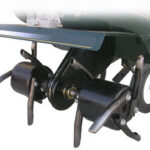Aeration, or removing plugs of soil from your lawn, results in a healthier, lusher lawn by letting more water, oxygen and nutrition reach its roots. Here are 10 tips for aerating your lawn.
1. How often to aerate depends on your climate and your lawn. For example, lawns in arid climates or those that receive a great deal of foot traffic may need to be aerated more frequently than those in wetter climates or less usage.
2. There are a number of ways to determine whether your lawn needs to be aerated. Lawn aeration helps to break up and penetrate compacted soil and thatch (grass clippings and other dead material that accumulate around the base of grass), which can block water, oxygen and nutriments from reaching lawn roots. Therefore, it is time to aerate if you notice a buildup of thatch in your lawn or if you have excess water runoff (which can be a sign of compacted soil). You can also cut out a piece of lawn and check the roots. If they are shallow and underdeveloped, your lawn probably would benefit from aeration. Likewise, if the surface of your lawn is dry and hard and it is difficult to penetrate with a screw driver, you may have compacted soil.
3. Choose an aerator that pulls plugs of soil out of your lawn, not one that punches holes in the lawn. Removing plugs allows more water, oxygen and nutrition to reach lawn roots than drilling holes.
4. Walking on your lawn in spiked shoes is not the same as aerating it.
5. Either aerate your lawn the day after a heavy rain or water your lawn well the day before you aerate, since moist and, therefore, soft soil is easier to aerate.
6. One reason to aerate is to break up tight, compacted soil. Lawn areas that receive the most traffic will have the most compacted soil and, as a result, may need to be aerated more often.
7. If you have a built-in sprinkler system, avoid sprinkler lines when aerating your lawn, especially if they are near the surface of the ground. You may want to mark sprinkler lines before starting to aerate so that you don’t accidentally puncture one.
8. Some lawn care experts say to remove aeration plugs, but a better alternative is to leave them on the lawn and to break them up with the mower the next time you cut the grass. They can help to encourage the growth of microorganisms that can reduce thatch build up.
9. Aerate your lawn in spring or fall when grass is growing rapidly and, therefore, when it can benefit the most from the greater access to water, oxygen and nutriments that results from aeration.
10. Don’t aerate during the hottest part of the summer when grass grows more slowly or may even go dormant.
Sources:
Dawn West, www.allaboutlawns.com, Lawn Aeration Tips to Give You a Greener Grass
Bob Formisano, homerepair.about.com, Lawn Aeration Tips



